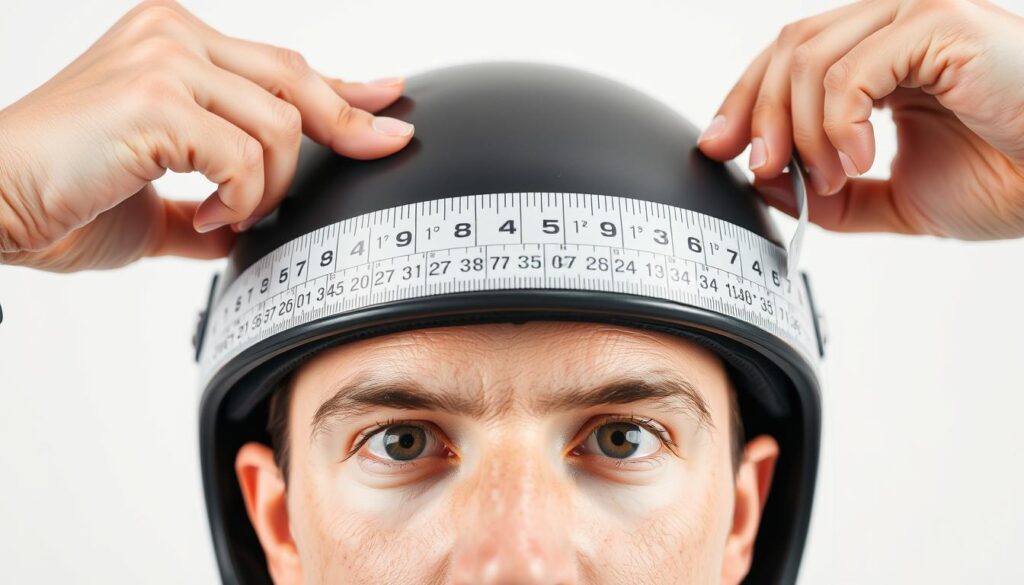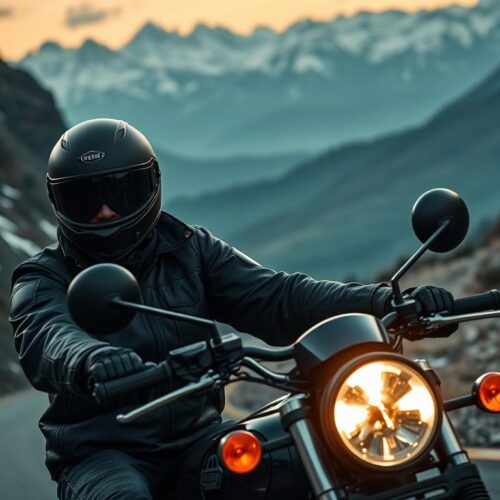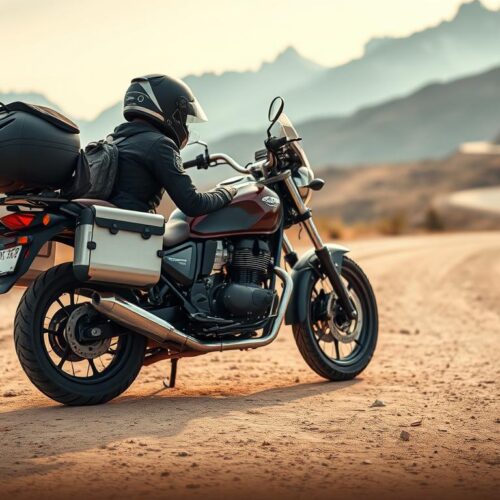Choosing the right motorcycle helmet is crucial when you ride. This detailed guide ensures you pick the best helmet for your needs. Helmets are essential for safety, not just an accessory. We’ll cover different helmet types, safety aspects, and why comfort matters. Whether you’re experienced or a newbie, this guide will help you find the ideal helmet for your journey.
Understanding Motorcycle Helmet Types
Finding the right helmet is vital for staying safe and comfy on your bike. There are different helmets for various riding styles and likes. Each kind has its own pros and cons that affect how you feel riding.
The full-face helmet gives top-notch safety, protecting your whole head and face. It cuts down on wind and noise, making your ride smooth. AGV and Shoei are known for their top-of-the-line full-face helmets with cool aerodynamics.
Modular helmets mix full-face and open-face features. They have a front part that flips up, letting riders easily switch between enclosed and open. This type is great for getting full-face benefits but with better air at stops.
Open-face helmets boost visibility and let lots of air in, giving you freedom around your face while keeping your head safe. Folks who dig a retro look often go for open-face helmets for the vibe and feel. Schuberth makes stylish and functional open-face helmets.
Half helmets are the simplest form, only covering the top of your head. They offer the least protection. But, they’re light and comfy for quick rides, making them a choice for some bikers.
Knowing the different helmet types helps you pick the right one for your riding. Always think about your riding style when choosing among full-face, modular, open-face, and half helmets. This way, you get a good mix of safety and comfort.
Important Safety Certifications to Look For
Choosing a motorcycle helmet means knowing about safety certifications. These show a helmet passed strict tests for safety and performance. Look for DOT, ECE
22.05, and Snell certifications. Each one means different safety levels.
DOT certification is needed in the U.S. It checks if helmets can resist impacts and stay on. Helmets with DOT marks give basic protection every rider needs.
ECE 22.05 certification is known worldwide. It not only measures how well a helmet can absorb a hit. It also looks at durability and comfort. ECE 22.05 helmets undergo tough tests to ensure they protect riders in many situations.
Snell rated helmets offer top safety standards. Snell tests are tougher than DOT and ECE. Choosing a Snell helmet means aiming for the best safety on your rides.
Knowing helmet certificates helps pick the right one. Whether it’s DOT, ECE 22.05, or Snell, you’re making safety a priority.
How to Measure Your Head for Helmet Size
Getting the right helmet size begins with measuring your head. Use a soft measuring tape for best results. Wrap the tape around the widest part of your head, above your eyebrows and ears. Make sure it’s snug but not too tight. This step is key for a good helmet fit.
To find your size, compare your measurement with the helmet sizing chart. Brands might have different charts, so check the manufacturer’s guidelines. A helmet that fits well can help prevent injuries. It’s important to measure your head for the correct helmet size.
After choosing a helmet, do the “shake test.” Put it on and gently shake your head. The helmet should stay put and not feel loose. If it moves too much, try adjusting it or pick another size. Also, wear the helmet to see if there are any uncomfortable spots on your forehead or temples. It should be snug but not painful, for the best protection while riding.

The Role of Comfort in Choosing a Helmet
When picking a motorcycle helmet, comfort is key. If it doesn’t fit right, long rides turn tough. A helmet that doesn’t fit well can make you tired and lose focus.
Helmets should have good padding inside. This makes sure the helmet fits your head just right. You can even find helmets with padding you can adjust to fit better.
Ventilation is important too. It keeps the air moving so you don’t get too hot. A helmet that’s not too heavy is also nicer to wear for a long time. It means less stress on your neck.
Top brands like Shoei and Arai don’t skimp on comfort. A well-made helmet makes riding your motorcycle much nicer.
| Feature | Importance | Tips |
|---|---|---|
| Padded Interiors | Enhances comfort and fit | Choose adjustable padding for a better fit |
| Ventilation | Prevents overheating | Look for adjustable vents for custom airflow |
| Weight | Reduces neck strain | Select lightweight materials |
Essential Features to Consider
Finding the right motorcycle helmet is more than just pick a size. It’s important to check out various features for a comfy and safe ride. Good ventilation is key because it prevents getting too hot on long rides. Many helmets have advanced ventilation systems for airflow without compromising safety.
Visor protection is crucial too. It keeps your eyes safe from UV rays, debris, and wind. Choose helmets with quality visors that are clear and won’t fog up. This reduces eye strain and keeps you focused on the road.
Bluetooth in helmets is a cool modern feature. It lets you talk hands-free and listen to music while riding. This is great for staying connected on group rides or using GPS without distractions.
| Feature | Description | Benefits |
|---|---|---|
| Ventilation | Airflow systems designed to keep the rider cool | Enhanced comfort during long rides |
| Visor Protection | High-quality visors for UV and debris protection | Improved visibility and reduced eye strain |
| Bluetooth Compatibility | Integration for communication and entertainment | Hands-free operation and easy navigation |
Knowing these key features can majorly boost your safety and fun when riding. Each feature adds to your comfort and protection on the road. They’re definitely worth thinking about when you’re helmet shopping.
The Importance of Fit and Snugness
Motorcycle helmets need to fit right to be safe. If a helmet is too loose, it might not protect well during a ride. It should be even on your head, right above your eyebrows, and tight around your cheeks.
Strap adjustments are very important. They need to be tight enough to be secure but not hurtful. A well-fitting helmet stays on during crashes and allows air flow and comfort on long rides. The shape of your head matters when picking out a helmet since different brands fit differently.
Many helmet makers offer guides to help you choose the right size and style. Trying on several helmets can show you which one fits the best. Always put fit first to be as safe as possible while riding.
Helmet Maintenance and Care
Keeping your motorcycle helmet in good shape is key to staying safe and making it last longer. You should clean and check your helmet regularly to spot any damage. Here’s how to take good care of it:
- Use mild soap and water to clean the exterior and interior of your helmet.
- Inspect the padding and straps for wear and tear.
- Store your helmet in a cool, dry place, away from direct sunlight.
It’s important to get a new helmet every three to five years or if it takes a big hit. This ensures your helmet’s safety features are always at their best. By following these tips, your motorcycle helmet will be ready for every journey.
| Maintenance Task | Frequency | Reason |
|---|---|---|
| Clean helmet exterior and interior | Every ride | Remove dirt and debris |
| Inspect for damage | Monthly | Identify wear and tear |
| Replace helmet | Every 3-5 years | Ensure maximum protection |
Aesthetics: Choosing the Right Design
Choosing a motorcycle helmet comes down to safety and style. Many seek helmets that protect and show off their personality. The market has lots of options to match different tastes.
Colors and designs play a big part in a helmet’s look. If you like simple colors or detailed patterns, there’s a helmet for you. Bright colors make you easier to see, which keeps you safe.
Consider these when looking at helmets:
- Design options that suit your personality.
- Colors that improve visibility while complementing the motorcycle’s look.
- Brand offerings known for their artistic creativity.
- Graphics that resonate with your passion and lifestyle.
By picking helmets that are safe and stylish, you can make a smart choice. Look at both looks and safety to choose a helmet you’ll be happy with.
Budgeting for Your Motorcycle Helmet
Buying a motorcycle helmet involves knowing the motorcycle helmet cost. Prices differ greatly because of the brand, materials, and safety features. Bell, HJC, and AGV have helmets that are affordable and also high-end, fitting any budget.
Budgeting for helmets means you can focus on safety and manage your spending. A good helmet is a way to protect yourself. Paying a little more means better safety and comfort, showing why it’s key not to cut corners on quality.

- Entry-level helmets: $100 – $200
- Mid-range helmets: $200 – $400
- Premium helmets: $400 and above
Think about if extras like air flow or a way to talk are worth more money. This helps you choose wisely, keeping your budget in check and staying safe on your bike.
Legal Requirements for Motorcycle Helmets
It’s vital for every rider to know the helmet laws in the U.S., as they change from state to state. Some places require everyone on a motorcycle to wear a helmet. Other states only ask certain riders to wear them, based on age or experience. Knowing these laws helps riders stay legal and safe.
In states with strict rules, wearing an approved helmet is a must for all. This shows their dedication to keeping riders safe. But, in places with looser rules, not wearing a helmet can increase the risk of getting hurt badly if there’s an accident.
If you don’t follow the helmet laws in your area, you might have to pay fines or see your insurance costs go up. So, it’s crucial to know your state’s helmet requirements to avoid trouble. Make sure to look up your local laws before you ride out. They might have changed or have specific rules you need to follow.
Making the Final Decision
As you near the end of choosing your motorcycle helmet, remember to look back at what we’ve covered. Think about the helmet types, safety marks, how it fits, and how much it costs. Every part of this will affect how much you enjoy riding and staying safe.
Choosing the right helmet depends on how you ride and what you like. You might want a full-face helmet for safety or an open-face for better view. Make sure it fits well and feels good to wear. This will make your rides better and keep you safe on the road.
In the end, choosing wisely means you get a helmet that’s safe and suits your way of life. Spending time to consider your options shows you’re serious about safe riding. This gives you confidence as you explore on your bike.




